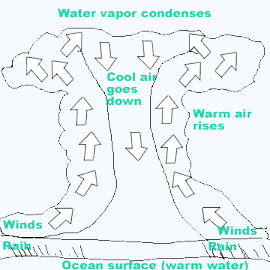Storm Preparation
Being prepared will help save your home and much more.
Disasters can happen anytime and anywhere, so it is important to be prepared before one strikes. Disasters can include windstorms, snow storms, hurricanes, earthquakes, and tornadoes. Some of these occur at specific times of the year, while others can strike at any time. Thankfully, there is a degree of predictability for hurricanes, which is why certain months of the year are known as the hurricane season. It never hurts to be prepared. It’s important to have the proper hurricane protection for your home or business. The real wild card when a storm hits is not water, which is fairly predictable in how it will come. It’s the wind. When strong winds come in a storm, they sometimes will rip apart poorly built structures and toss the pieces of wood or metal like missiles around the property. And that’s what does a lot of the unpredictable damage. This is why hurricane window protection is essential.
A hurricane is a tropical cyclone, which generally forms in the tropics and is accompanied by thunderstorms and a counterclockwise circulation of winds, seasoned normally from June to November.
Hurricanes have four stages:
Tropical disturbance: rain clouds (Moist air rises and becomes cooler)
Tropical depression: thunderstorms (low pressure–winds with circular patterns
Tropical Storm: 38 miles an hour wind (storm clouds–rough seas)
Hurricane: more than 74 miles per hour wind and heavy rain (a developed eye and eye wall)

- STORM SURGE – is water that is pushed toward the shore by the force of the winds swirling around the storm. This advancing surge combines with the normal tides to create the hurricane storm tide, which can increase the mean water level 15 feet or more.
- INLAND FLOODING – In the last 30 years, inland flooding has been responsible for more than half the deaths associated with tropical cyclones in the United States.
- HIGH WINDS – Hurricane-force winds can destroy poorly constructed buildings and mobile homes. Debris such as signs, roofing material, and small items left outside become flying missiles in hurricanes.
- TORNADOES – Hurricanes can produce tornadoes that add to the storm’s destructive power. Tornadoes are most likely to occur in the right-front quadrant of the hurricane.
- A HURRICANE WATCH is issued for your part of the coast. This indicates the possibility that you could experience hurricane conditions within 36 hours. This watch should trigger your family’s disaster plan, and proactive measures should be initiated especially those actions that require extra time such as securing a boat, leaving a barrier island, etc.
- A HURRICANE WARNING is issued for your part of the coast. This indicates that sustained winds of at least 74 mph are expected within 24 hours. Once this warning has been issued, your family should be in the process of completing proactive actions and deciding the safest location to be during the storm.
By taking very simple precautions and planning for your family, you will be better prepared in case a disaster strikes. You will therefore be better able to cope during the emergency.
- Look for loose parts of structures (patios, porches, fences, etc.) outside of your house. If you can shake them with your hand, secure them or remove them. The time to begin acquiring shutters and protection for your home is now. All openings of your home need to have protection to keep fierce winds and rain out of the building. Experience proves that a home that does not have protected openings is at grave risk for serious damage.
- Trees need to be trimmed to minimize the damage they may cause to your home or someone else’s. Vehicles left out in the open are often overturned by high winds. If you do not have a garage or carport, locate a protected spot to park your vehicles. A good location might be on the leeward side of the house, away from the main force of the wind.
- Check for any loose electrical wiring or shaky gas connections, inside and outside. Repair them, if you can; call a contractor if you can’t. For items located outside, such as lawn furniture, grills, toys, yard equipment, etc., that should be brought inside before a storm. When picked up by high winds, these items can become deadly missiles. Fasten shelves and hanging units inside your house; place heavier items on lower shelves. Make sure pictures, mirrors and other items are hanging away from beds or couches. If they’re nearby, take them down. Make sure your water heater is strapped to wall studs or another solid base.
- Examine your home to see if hurricane straps and connectors were installed to roof trusses, rafters and framing members. Homes that do not have such protective reinforcement are at risk of loosing roofs and walls to strong hurricane force winds.
- Past experiences of Hurricanes have taught us that we need to be prepared to live without our utilities and basic services for up to two weeks or more. Most of us are ill-prepared to do so. It is not immediately obvious what we would need for such an adventure. A useful exercise may be to try to live for one day without your utilities and begin making a list of essential items that become evident. Parents should try an occasional “one-day camp in” with their children. This will make it less traumatic for children (and their parents) when they are forced to live without all the things we take for granted.
- It is also important to fuel all vehicles before the storm hits. In addition, remember to get to the ATM or bank and secure some cash since banks will probably be closed for some time after a severe storm. Finally, keep a photo I.D. that also shows your home address. This may become important when asking a police officer or National Guardsman for permission to re-enter your neighborhood.
- Storms and weather fronts, especially tornados and hurricanes, can move very quickly. Hurricanes typically move at a forward speed of 8 to 25 miles per hour. While this may seem quite slow, such movement can advance an approaching storm up to 200 miles during the course of a normal work day. As a hurricane or other storm moves closer to you area, begin monitoring the weather reports every hour. Don’t get caught by surprise by not taking advantage of the excellent media coverage of weather related events.
- Weather Update
- Hurricane Preparation
- Hurricane Categories
- US Coast Guard
- Hurricane Survival Kit
- Computer Care
- FEMA

- 17 Years of Experience
- Famly Owned
- Factory Direct Pricing
- 12000+ Home Installation












